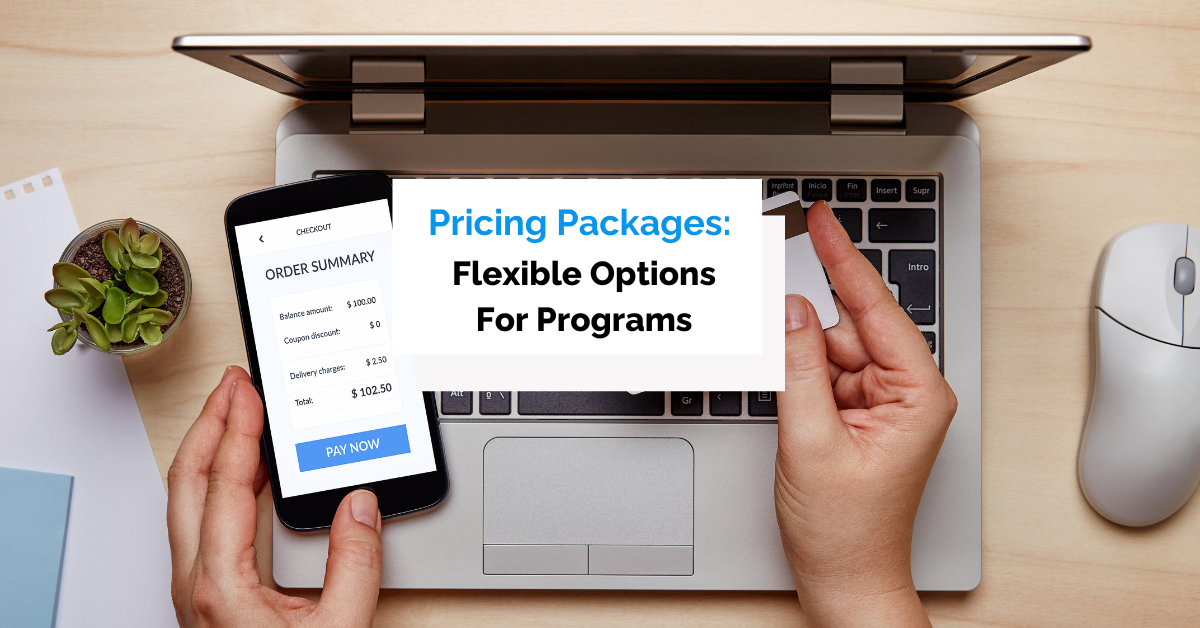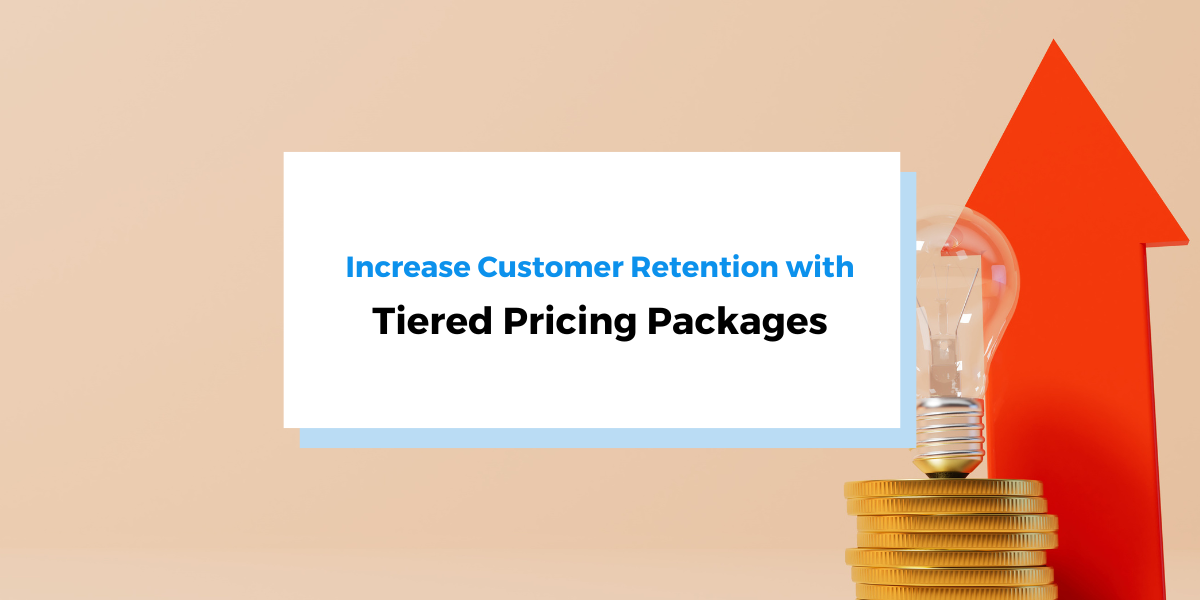So, you’ve decided to make online camp registration a reality, but don’t know where to begin?
In this article, we’ll tell you all about the challenges and the rewards of setting up online registrations, providing an ultimate guide to the process.
In some ways, figuring out online registrations is just like the first time you set up your camping tent.
The task might seem daunting at first, but with proper instructions and by following the right steps carefully, you’ll manage to make it to the end.
Hopefully, you’ll also get rewarded with spending a cozy night outdoors, warmed by the campfire.
Following the five steps we present here, you can make your camp’s registration process easier for parents and administrators alike, thus improving the efficiency and reputation of your business.
To start, you need to choose the right registration software.
- Choose a Camp Registration Software
- Present Your Camp Offerings
- Create Your Camp Registration Forms
- Set up Online Payments
- Configure Automatically Triggered Emails
- Conclusion
Choose a Camp Registration Software
Just like building a campsite requires a particular set of tools, setting up online camp registrations calls for finding the optimal software solution.
Of course, you could probably figure out how to put up the tent and start a fire without using a hammer and matches.

Source: @mixetto by Canva
However, that would mean compromising on either time or quality. If you wanted to make sure your tent was reliably sturdy before nightfall, neither of those options would seem appealing.
Similarly, camp registration software should act as a toolbox with all the necessary tools to make registration faster, easier to manage and provide a better user experience.
In other words, your final decision will significantly impact every part of the registration process, so you shouldn’t settle for the first product you see on the shelf.
Every camp is different, and so are their registration needs.
To find the camp registration platform that suits you best, start by assessing the unique requirements of your camp and the registration experience you wish to provide.
Additionally, don’t overlook the importance of user experience. As Jim Ross, a senior user experience architect, says in his booklet on the value of UX:
Whether you purposely try to design a good user experience or not, people will always have an experience (good or bad) when using a product or system.
Ross also shares some of the negative consequences of sub-par user experience from the product and business perspective:
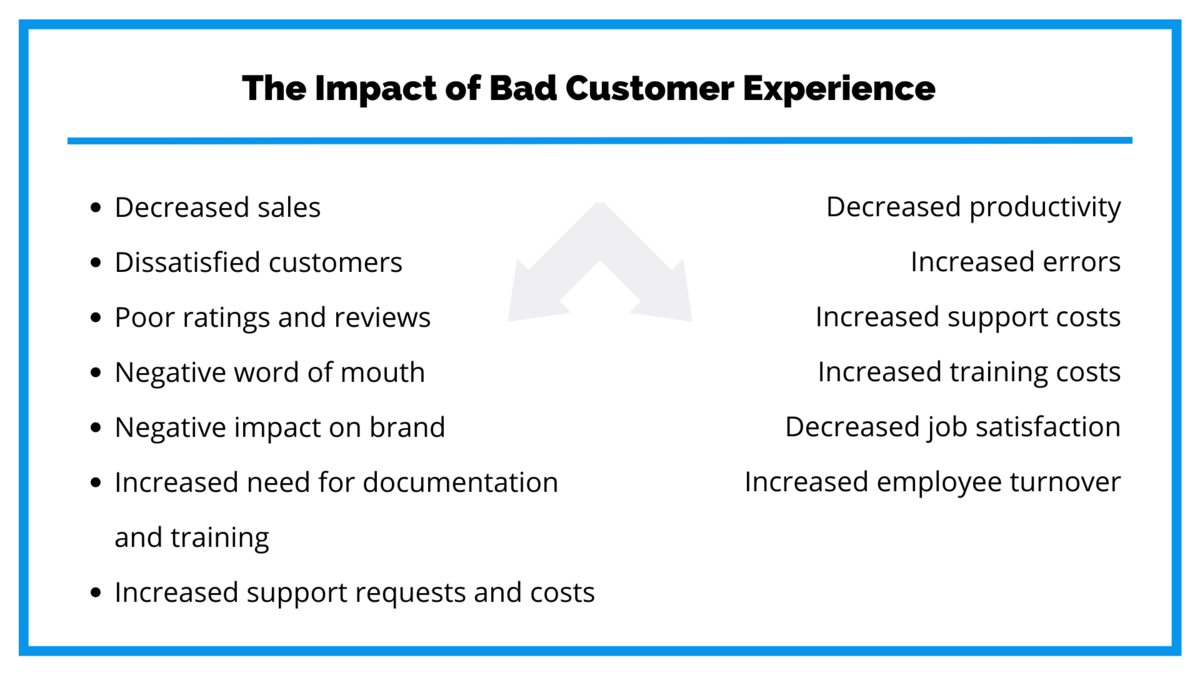
Source: Infragistics / Illustration: Regpack
Now, there will always be limitations to consider, the most impactful being the price.
If everyone could afford the best, most feature-packed option, there would be no reason for alternatives to exist. Moreover, not everyone will need the same things from your software.
Still, there are some features that both help your camp’s administration efforts and provide a better user experience and can be found in affordable options.
Features like group registrations, online payments, and mobile support give your customers more flexibility while saving administration time in handling issues regarding those three aspects.
Similarly, smart registration forms, email communication, and responsive customer support save a lot of time and effort for both sides, while tracking and reporting provide intelligence to help your camp improve upon everything mentioned so far.
Now that you’ve identified the tools required for the job, it’s much easier to choose the right toolbox.
Overall, selecting the right camp registration software is the crucial first step in streamlining your online registrations, facilitating the process for camp administration and parents alike.
In the next section, we’ll explore best practices in presenting your programs to your target audience.
Present Your Camp Offerings
Implementing online registrations includes more than just allowing parents to enroll children in your camp over the Internet.
It is about improving the entire registration experience to make it as convenient as possible for parents to enroll their children in your camp.
Therefore, before registration even begins, you should ensure information about the available programs and sessions for your camp can be effortlessly found on its website.
Otherwise, one of two things will happen.
Number one, you will be inundated by emails and calls from parents interested in the camp, but needing help locating the information they are looking for.
This would still be manageable, as your camp’s customer support could provide them with session dates.
However, as interest grows, the staff can quickly become overwhelmed with calls and emails on the subject, preventing them from tending to more pertinent issues.
Number two, the lack of information can discourage them so they move on to looking at other options.
Unless you are actively trying to cut down attendance, it doesn’t take much elaboration on why this is unfavorable.
A great tip for avoiding both adverse outcomes is presenting the camp’s programs and sessions in a clear and organized form.
Take a look at an example from AHRC New York City Camping:
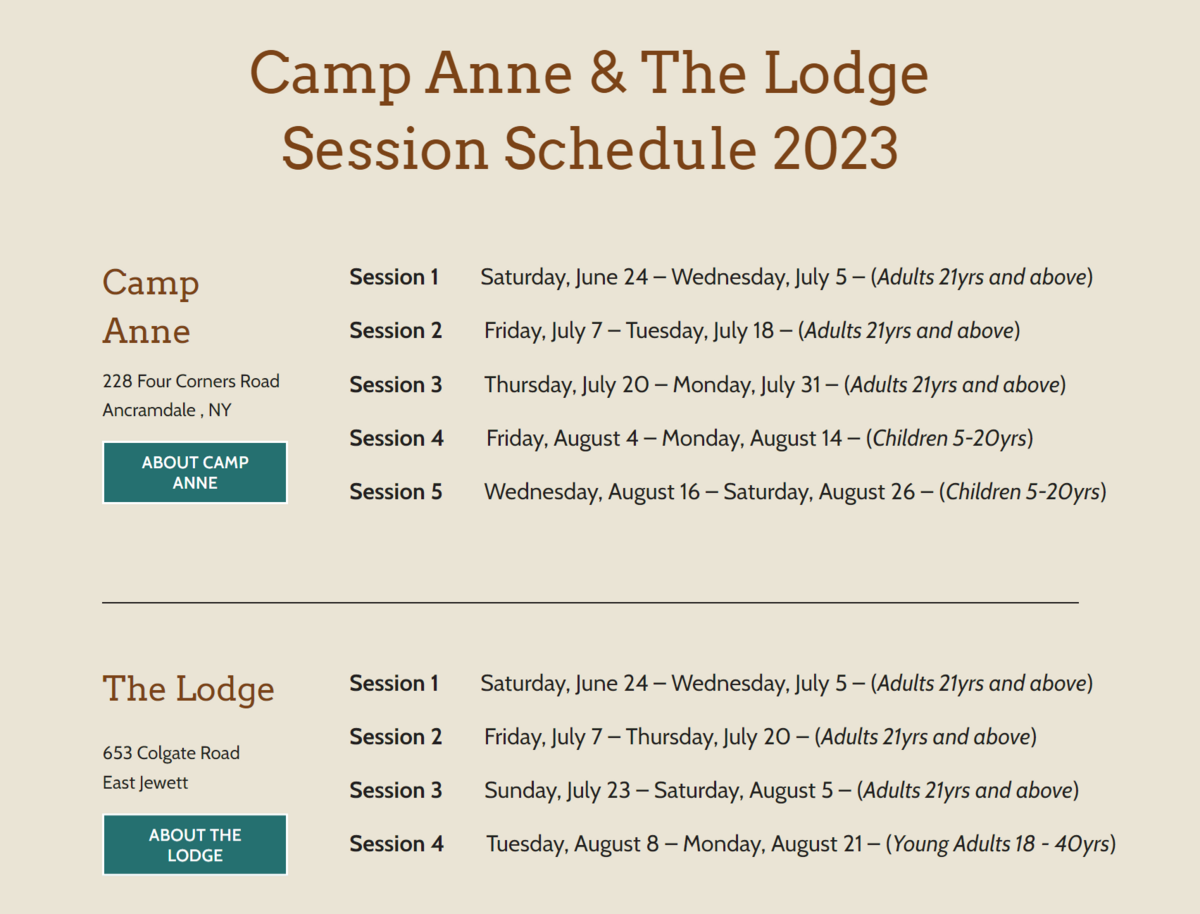
Source: AHRC New York City Camping
While just listing entries in chronological order is a workable solution, for camps with a larger number of activities sorting out the information could become cumbersome.
With online registration software, you can easily create as many programs and sessions as you need and display them in multiple places on your website.
There are multiple types of products you can make, from programs with sessions, membership programs, and one-time events, to merchandise and discounts.
As for sessions, the preferences allow you to set the dates, times, prices, and the number of available spots.
Furthermore, you can put products in filterable categories to make it easier for parents to find the ones they are interested in.
Also helping in that regard is the ability to make different forms for different types of programs.
If you offer, for example, painting classes in your camp, you can place all painting activities on a separate webpage from other program categories.
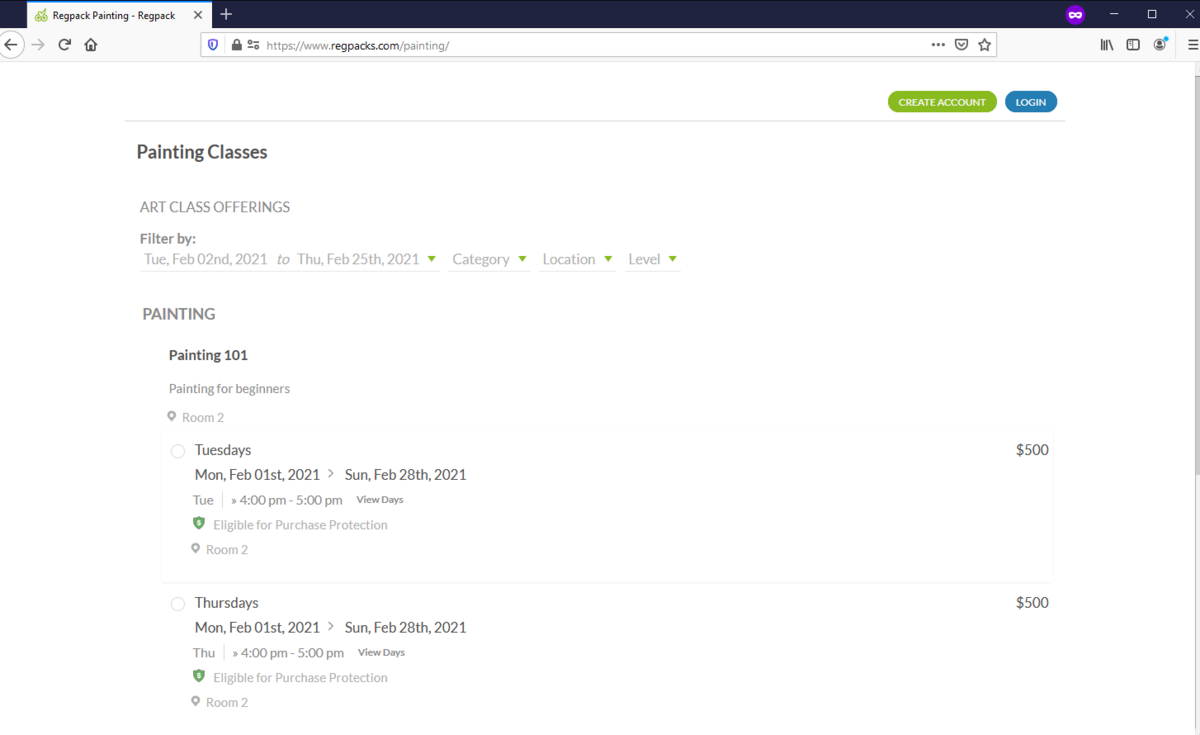
Source: Regpack
Overall, a clear presentation of your camp’s products and sessions will facilitate more registrations and save a lot of time and effort for your customer support.
Create Your Camp Registration Forms
Some look at registration forms as just a stepping stone between parents wanting to enroll their children into the camp and securing a spot.
However, the placement of the forms, design, and the questions they contain are central to the online registration experience.
How?
To answer, let’s look at some research on the subject.
In a survey by the Manifest, 81% of respondents said they abandoned an online form in the past, with 59% admitting to doing it within the last month.
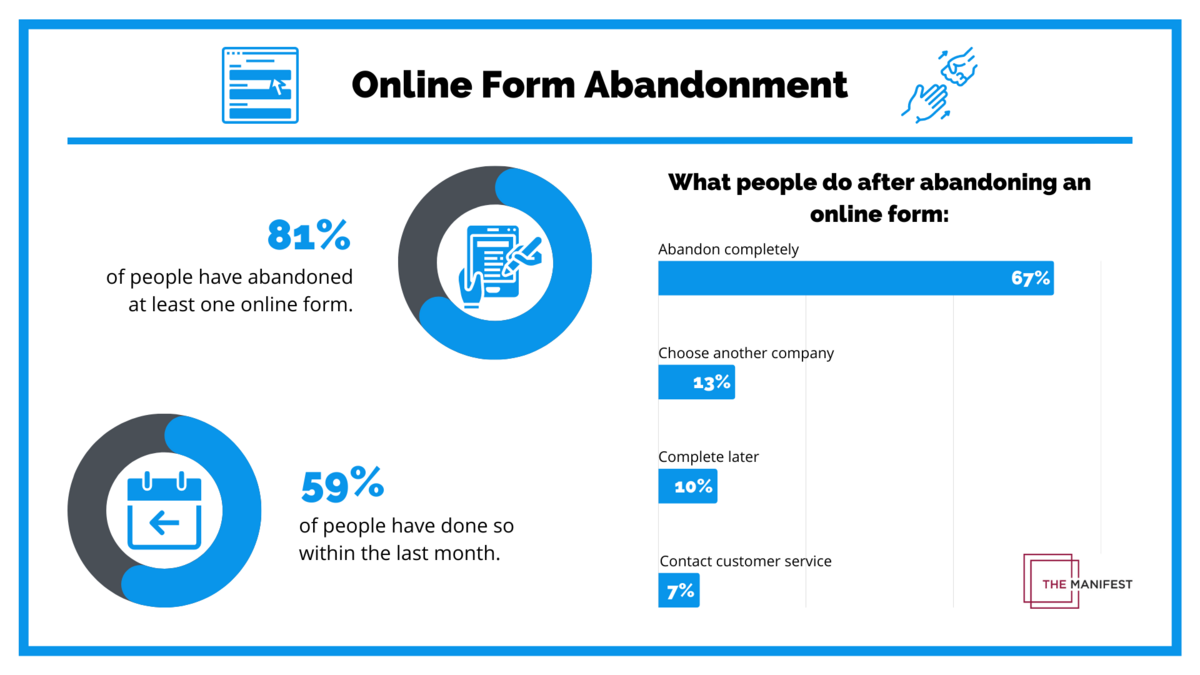
Source: The Manifest / Illustration: Regpack
Moreover, most of the time, the form is abandoned altogether. A number of reasons are cited as the cause, with lengthy forms and unnecessary questions being among the top answers.
Therefore, you need a design that will be pleasing to the eye, have the right type and amount of queries, and function as expected.
Fortunately, camp registration software such as Regpack offers all of the above with customized online forms that keep parents engaged throughout the registration procedure.
As shown below, their online form builder allows you to simply drag and drop elements you want to be included, like name, email, phone, etc.
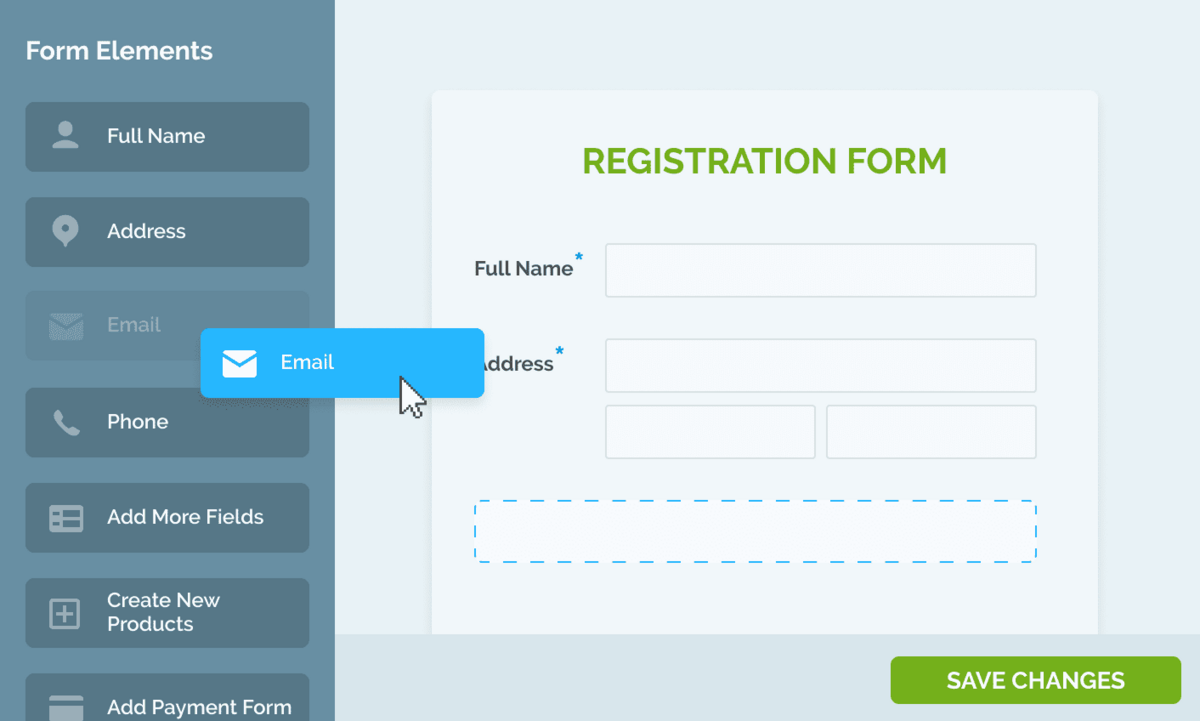
Source: Regpack
From there, more customization options are available.
You can appoint mandatory fields, choose and configure one of many stylish designs, and create optional questions for the conditional logic system.
Conditional logic helps you to streamline registrations by showing parents only the questions relevant to their situation.
For example, answering yes to “Have your children attended a summer camp in the past?” can lead the user to two questions about the experience, while answering no skips that part directly to the next question.
When you are done designing the perfect registration form, one that asks just the right questions, you can embed it directly onto your website. 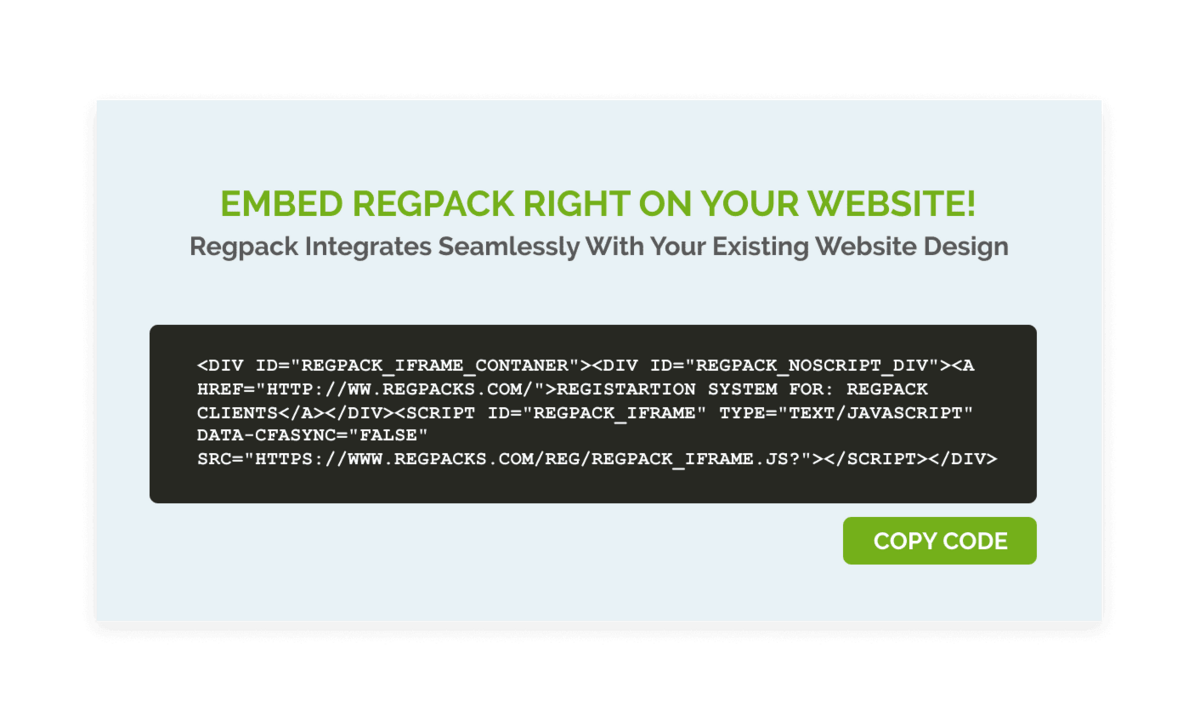
Source: Regpack
All you need to do is copy and paste a single line of HTML code, and your users will not have to redirect to shady third-party sites, making for a seamless registration experience.
Ultimately, registration forms can make or break enrollments for your camp, which is why you need ones that are user-friendly, customizable, and thoroughly functional.
Set up Online Payments
Each step of the way to setting up online camp registrations has a common denominator, and that’s convenience.
To stay true to form, it’s also important to make it easy for parents to pay for the programs they registered for. To achieve that, your camp should have an online payment processor.
This is a natural extension of the registration process, therefore your payment forms should follow the guidelines outlined in the previous section.
But in addition to being fast, simple, and functional, it’s crucial that they offer a high level of security as well.
As reported by FinTech Global, a 2023 survey from BR-DGE found that 83% of online shoppers still worry about security when making online purchases.
Regarding the results, BR-DGE’s retail payments expert Mark Whybrow concluded that businesses wanting to use their online channels for growth must consider adapting their payment journey to meet consumer needs.
On that, he added:
This research highlights the opportunity to improve the customer experience of payments and reduce failed transactions by optimizing their payments infrastructure. As consumer budgets tighten, the importance of offering a first-class end-to-end payment experience is even more important in order to build customer loyalty.
Therefore, when looking at payment solutions, security should be your top priority.
If you can, try to find software registration software with PCI-compliant payments.
PCI DSS is an industry standard for secure credit card payments, pretty much guaranteeing your users won’t get defrauded of their money or other sensitive data.
For the rest, you should ensure your camp can process several payment types. For online payments, credit and debit cards are a given.
Offering one or more alternative payment methods—for example, e-checks—will provide parents with options, making paying a little more convenient still.
Also, it’s a big plus for your registration platform if it supports automatic recurring payments.

Source: Regpack
After all, taking care of children comes with its own set of expenses.
Parents will appreciate the option to split the enrollment fees into smaller installments, as they can secure a spot for their children early instead of having to wait for months to save enough money.
Configure Automatically Triggered Emails
The core of any functioning relationship is communication.
This sentiment is commonly expressed when it comes to people, but it’s starting to ring true to more and more businesses, especially the ones dealing with online customers.
And that encompasses more than answering customers’ questions or resolving issues. It also means keeping them informed and engaged in the online registration process.
By setting up automatically triggered emails, you ensure parents will receive the relevant messages after completing specific actions.
A good example are conformations sent for successfully finalizing registration or payment, such as this one:
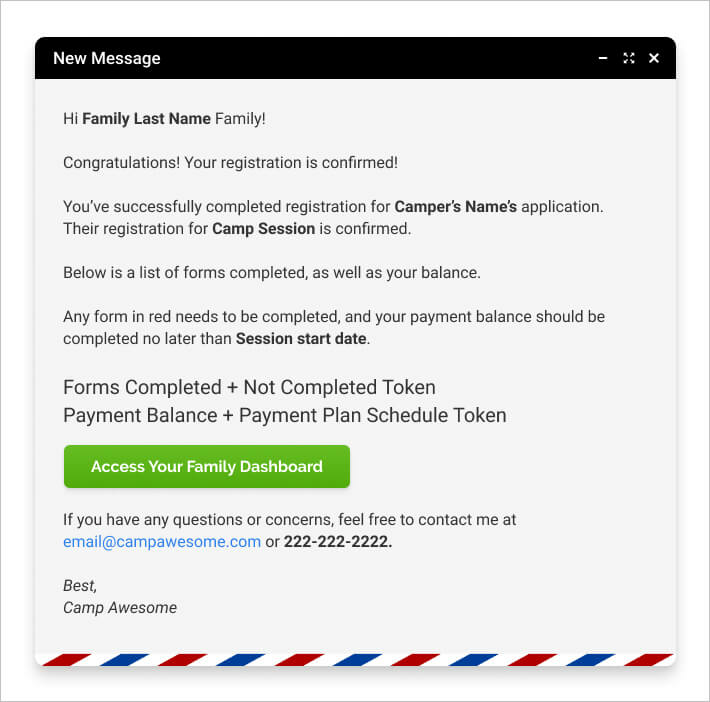
Source: Regpack
Without this kind of message, parents could be left feeling uneasy, wondering if the payment went through.
This will most likely result in calls to customer service to verify the payment went through.
In that case, even with everything going the way it should, it can still make parents doubt the trustworthiness of your camp and second-guess their decisions.
With the right registration software, configuring email triggers should be fairly basic.
To begin, you need to create an email template with fields that automatically fill out with the user’s information. That way, you won’t have to write messages to each user individually.
Then, you need to assign triggers—the conditions that must be met for the email to go out.
It should look something like this:
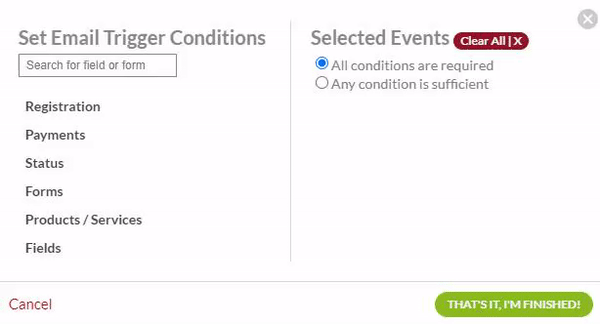
Source: Regpack
As you can see, emails can be assigned for various activities. Apart from conformations, you can also trigger status emails, notifications, and offers.
All in all, an effective communication strategy means following your customer through their registration journey, providing them with well-needed information and support to keep moving forward.
Conclusion
Like putting up a tent, setting up online registration for your camp is more than just reading instructions.
You have to put yourself out there, get your hands dirty, and spend some time and effort putting what you learned into practice.
In this article, we’ve shared five clear steps on how to make online registrations a reality for your camp.
When you implement them, the reward will feel even better than spending a relaxing night camping in nature.



